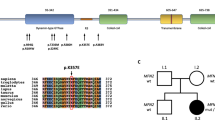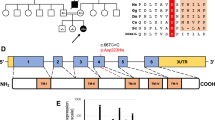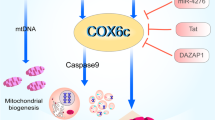Abstract
Mitochondrial complex IV (cytochrome c oxidase, COX) is essential for oxidative phosphorylation, and pathogenic variants of COX-related genes, such as COX6A1, are associated with neuromuscular disorders. While recessive COX6A1 variants are linked to Charcot-Marie-Tooth disease (CMT), the phenotypic spectrum and molecular mechanism remain incompletely understood. Here we report a 2-year-4-month-old girl who presented with global developmental delay, axonal CMT disease, and elevated lactate levels. WES revealed a rare homozygous COX6A1 variant (NM_004373.4: c.329 A > T, p.110Leuext41) that is absent in population databases. This variant is 41 amino acids longer than the wild-type protein. Functional assays demonstrated significantly reduced mutant protein levels (p < 0.01), supporting the pathogenicity of this mutation. The patient experienced rapid decompensation and died following febrile illness at the age of 3.5 years. This study revealed a novel pathogenic COX6A1 variant that causes developmental delay and mitochondrial dysfunction, highlighting stop-loss mutations as a mechanism of disease. We report the first COX6A1 stop-loss variant, and our findings expand the phenotypic and genetic spectrum of COX6A1-related disorders.
This is a preview of subscription content, access via your institution
Access options
Subscribe to this journal
Receive 12 print issues and online access
$259.00 per year
only $21.58 per issue
Buy this article
- Purchase on SpringerLink
- Instant access to full article PDF
Prices may be subject to local taxes which are calculated during checkout



Similar content being viewed by others
Data availability
The data that support the findings of this study are available from the corresponding author upon reasonable request.
References
Valnot I, von Kleist-Retzow JC, Barrientos A, Gorbatyuk M, Taanman JW, Mehaye B, et al. A mutation in the human heme A:farnesyltransferase gene (COX10) causes cytochrome c oxidase deficiency. Hum Mol Genet. 2000;9:1245–9.
Alfadhel M, Lillquist YP, Waters PJ, Sinclair G, Struys E, McFadden D, et al. Infantile cardioencephalopathy due to a COX15 gene defect: report and review. Am J Med Genet A. 2011;155a:840–4.
Szklarczyk R, Wanschers BF, Nijtmans LG, Rodenburg RJ, Zschocke J, Dikow N, et al. A mutation in the FAM36A gene, the human ortholog of COX20, impairs cytochrome c oxidase assembly and is associated with ataxia and muscle hypotonia. Hum Mol Genet. 2013;22:656–67.
Dong HL, Ma Y, Yu H, Wei Q, Li JQ, Liu GL, et al. Bi-allelic loss of function variants in COX20 gene cause autosomal recessive sensory neuronopathy. Brain. 2021;144:2457–70.
Tamiya G, Makino S, Hayashi M, Abe A, Numakura C, Ueki M, et al. A mutation of COX6A1 causes a recessive axonal or mixed form of Charcot-Marie-Tooth disease. Am J Hum Genet. 2014;95:294–300.
Laššuthová P, Beharka R, Krůtová M, Neupauerová J, Seeman P. COX6A1 mutation causes axonal hereditary motor and sensory neuropathy - the confirmation of the primary report. Clin Genet. 2016;89:512–4.
Li H, Durbin R. Fast and accurate short read alignment with Burrows-Wheeler transform. Bioinformatics. 2009;25:1754–60.
Wang K, Li M, Hakonarson H. ANNOVAR: functional annotation of genetic variants from high-throughput sequencing data. Nucleic Acids Res. 2010;38:e164.
Richards S, Aziz N, Bale S, Bick D, Das S, Gastier-Foster J, et al. Standards and guidelines for the interpretation of sequence variants: a joint consensus recommendation of the American College of Medical Genetics and Genomics and the Association for Molecular Pathology. Genet Med. 2015;17:405–24.
Mills JF, Heiland LD, Nguyen SA, Close MF, Meyer TA. Charcot-marie-tooth disease and hearing loss: a systematic review with meta-analysis. Otol Neurotol. 2024;45:732–9.
Laurá M, Pipis M, Rossor AM, Reilly MM. Charcot-Marie-Tooth disease and related disorders: an evolving landscape. Curr Opin Neurol. 2019;32:641–50.
Ross JM, Öberg J, Brené S, Coppotelli G, Terzioglu M, Pernold K, et al. High brain lactate is a hallmark of aging and caused by a shift in the lactate dehydrogenase A/B ratio. Proc Natl Acad Sci USA. 2010;107:20087–92.
Morena J, Gupta A, Hoyle JC. Charcot-marie-tooth: from molecules to therapy. Int J Mol Sci. 2019;20:3419.
Rossor AM, Carr AS, Devine H, Chandrashekar H, Pelayo-Negro AL, Pareyson D, et al. Peripheral neuropathy in complex inherited diseases: an approach to diagnosis. J Neurol Neurosurg Psychiatry. 2017;88:846–63.
Parkinson MH, Bartmann AP, Clayton LMS, Nethisinghe S, Pfundt R, Chapple JP, et al. Optical coherence tomography in autosomal recessive spastic ataxia of Charlevoix-Saguenay. Brain. 2018;141:989–99.
Baumann M, Schreiber H, Schlotter-Weigel B, Löscher WN, Stucka R, Karall D, et al. MPV17 mutations in juvenile- and adult-onset axonal sensorimotor polyneuropathy. Clin Genet. 2019;95:182–6.
Tomaselli PJ, Rossor AM, Horga A, Laura M, Blake JC, Houlden H, et al. A de novo dominant mutation in KIF1A associated with axonal neuropathy, spasticity and autism spectrum disorder. J Peripher Nerv Syst. 2017;22:460–3.
Pitceathly RD, Murphy SM, Cottenie E, Chalasani A, Sweeney MG, Woodward C, et al. Genetic dysfunction of MT-ATP6 causes axonal Charcot-Marie-Tooth disease. Neurology. 2012;79:1145–54.
Comi GP, Bordoni A, Salani S, Franceschina L, Sciacco M, Prelle A, et al. Cytochrome c oxidase subunit I microdeletion in a patient with motor neuron disease. Ann Neurol. 1998;43:110–6.
Liu W, Gnanasambandam R, Benjamin J, Kaur G, Getman PB, Siegel AJ, et al. Mutations in cytochrome c oxidase subunit VIa cause neurodegeneration and motor dysfunction in Drosophila. Genetics. 2007;176:937–46.
Brischigliaro M, Zeviani M. Cytochrome c oxidase deficiency. Biochim Biophys Acta Bioenerg. 2021;1862:148335.
Acknowledgements
We are grateful to the patient and the family members who participated in this study. We also thank CIPHER GENE for their support of the WES.
Author information
Authors and Affiliations
Corresponding author
Ethics declarations
Competing interests
The authors declare no competing interests.
Additional information
Publisher’s note Springer Nature remains neutral with regard to jurisdictional claims in published maps and institutional affiliations.
The author first listed made the greatest contribution to the paper.
Rights and permissions
Springer Nature or its licensor (e.g. a society or other partner) holds exclusive rights to this article under a publishing agreement with the author(s) or other rightsholder(s); author self-archiving of the accepted manuscript version of this article is solely governed by the terms of such publishing agreement and applicable law.
About this article
Cite this article
Cai, Q., Wang, H., Luo, R. et al. A novel homozygous COX6A1 variant causes axonal charcot-marie-tooth disease, developmental delays and mitochondrial dysfunction. J Hum Genet (2025). https://doi.org/10.1038/s10038-025-01411-4
Received:
Revised:
Accepted:
Published:
DOI: https://doi.org/10.1038/s10038-025-01411-4



